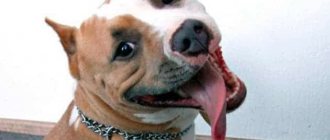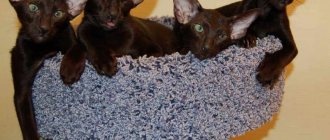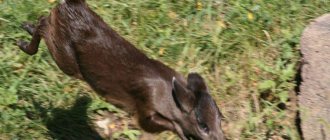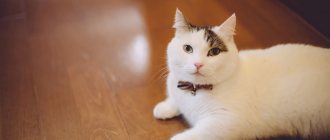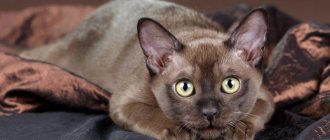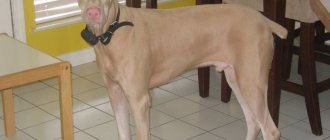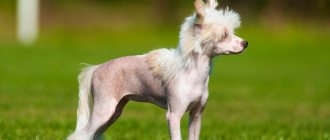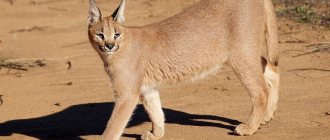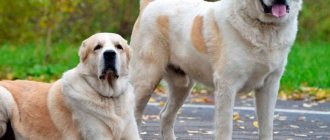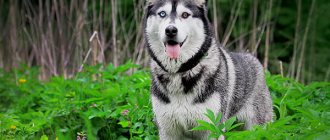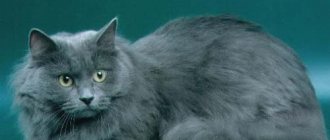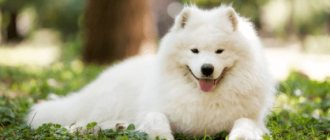The Abyssinian cat breed has been known since ancient times. These pets were considered sacred, and their owners were the pharaohs themselves. How much does an Abyssinian cat cost, where is the best place to buy one, and other features, we suggest you learn from the material presented.
The Abyssinian cat has features from the wild puma in appearance, and this gives it unique beauty and majesty. Meanwhile, the cat’s disposition is moderately cheerful, and even an adult animal wants to constantly be active, play, frolic, and climb. Balanced people who strive for peace and quiet can quickly get tired of the antics of the Abyssinian cat, so this breed should be chosen by sanguine and choleric people who are always on the move.
Description of the breed, character, features, colors
The Abyssinian cat is a medium-sized pet. An adult animal at the withers reaches a height of 28-32 cm, weight – up to 7 kg. The Abyssinian has a slender and tall body, long and thin limbs, and small oval paw pads. The tail of this cat is long, quite thick at the base and tapers towards the tip.
Breeders came to the conclusion that when crossing Abyssinians of different colors, the offspring inherits only one color, characterized by a dominant gene. By the way, babies of different colors are not found in one litter.
Abyssinian has extraordinary external characteristics. She has a slightly elongated head, a round muzzle with cheeks, a small nose, and her chin does not protrude forward. What distinguishes the animal of this breed from other representatives is its large ears with dark tips, which can end in tassels. By the way, earlier the tassels were much thicker, which was a distinctive feature, but gradually they appeared less frequently.
The Abyssinian cat has large, almond-shaped eyes with black eyelid rims and light fur around the eyes. It is the wool that is considered the special pride of the presented breed. The even, smooth, soft and very pleasant to the touch fur can be compared to silk. The short hairs of the fur have four colored stripes (ticking), however, distributed evenly over the body, they do not create a pattern. The hairs at the roots are almost white, ticking is distributed along the entire length of the hairs. The tail at the tip, back and soles of the hind legs are characterized by a rich dark pattern. The chest, neck and belly are lighter in color. Abyssinian cats do not have stripes or spots: the fur over the entire surface of the body is evenly colored (from light to dark).
Based on the CFA association, 4 types of colors of Abyssinian cats are recognized:
- Red, or sorrel. This species is characterized by a light beige, peachy hue, but can vary to dark chestnut with a red undercoat. Pets with this color will have a pink nose and paw pads.
- Wild. This color is close to dark brown with a reddish undercoat and black tips. Among Abyssinians this color is the most common.
- Blue. This tone creates the feeling of a tailcoat. The upper coat (back, head, tail) is distinguished by a blue-gray tint, while the lower coat (the inner part of the limbs and tail, belly) is ticked blue.
- Silver or tortoiseshell. According to European standards, these varieties are allowed. The tortoiseshell color is formed by alternating light gray and dark gray ticking. There are 3 types of silver colors:
- the roots have a white color;
- in the middle – gray;
- at the tips - black.
In Abyssinian cats, coat colors usually develop before they are 2 years old.
The character of the Abyssinians is characterized by friendliness and relative complaisance. The pet is devoted to its owners, and it is ready to follow them tirelessly on their heels. These cats suffer from loneliness painfully. The presented breed is more active than other felines. Abyssinians are inquisitive, interested in everything and try not to miss anything, to take part in everything. This pet will not let you get bored, but you need to understand that this cute creature can turn the whole house upside down. To prevent anything like this, the Abyssinian should always find something to do. To do this, you should stock up on cat exercise equipment and toys. This animal loves heights, so it makes sense to build it yourself or buy a device for climbing up so that the pet can watch its owners.
The Abyssinian cat has a very positive attitude towards guests. She can meet, explore, sniff a stranger who comes, and if he decides to play with the pet, he will gladly support such a desire.
The Abyssinian is considered an excellent conversationalist. He will purr and communicate with the owner if the latter begins to talk to the pet.
Abyssinian cats easily get used to a new home and can get along well with other pets. They love children, but will not allow themselves to be offended. The offended Abyssinian may not fight back, but he will no longer play and be friends with the offender.
This breed is one of the most ancient among cats. Images of Abyssinian cats were found on frescoes and runes of Ancient Egypt. Cat statues of various sizes were found even in the tombs of the pharaohs. The Egyptian Book of the Dead contains descriptions of “lapis lazuli cats of the horizon” and “sun cats”, which were similar to the Abyssinian breed.
It has been argued for quite a long time that the homeland of these animals is Abyssinia, that is, modern Ethiopia. Meanwhile, a study of genetic data points to southeast Asia, in particular the coast of Indonesia.
The graceful Abyssinian cat first appeared before the public in London at an exhibition in 1871. At that time, these animals were called “Zulu” or “Zula”.
Breeders stated that the Abyssinian was caught during the First Abyssinian War. Although images of animals that are similar to Abyssinian cats, as mentioned above, were found much earlier. Be that as it may, there is no reliable information about the specific place and period of this breed, despite the fact that many scientists are inclined to consider the version of the import of the breed from the islands of Indonesia.
Description
Abyssins are considered highly active cats that will happily indulge in games, both independently and in the company of their owner. The animals are quite affectionate, friendly, very active and intelligent. They do not require special care, but it is still important to know the peculiarities of keeping the breed. The average lifespan of an animal is 12-15 years.
Coat and color
Abyssinian wool is unusual due to its ticking. Ticking is a special coat color in which each hair is decorated with barely noticeable stripes. Usually there are from 2 to 6 stripes on the hair. They differ from the main color, but do not stand out from the general color scheme. Thanks to ticking, the animal's fur shimmers beautifully in different shades.
According to the World Cat Owners Organization, there are only four color options for the breed: wild, red, blue and beige. The wild color involves black stripes on a red-brown coat. Brown ticking on an apricot base is called red. The blue color is an apricot coat with blue-gray stripes. An ivory-colored coat combined with beige-pink streaks is a sign of a beige color. A silver coat color is possible, on which any ticking color is considered acceptable.
The lilac and chocolate color of the Abyssinian cat is not generally accepted, but is possible for some evaluation systems.
The cat's color is darker on the soles of its paws, back, and tip of its tail, but lighter on the inside of its paws, belly and chest.
Constitution
Abyssinian cats have a well-developed body. The legs are long and slender. The tail is thin, wider at the base. Thanks to their high activity, their muscles are always toned. The harmoniously built body is decorated with a proportionally set wedge-shaped head. A pointed muzzle is not acceptable.
The almond-shaped eyes are decorated with black eyeliner, making them stand out noticeably on the face. A round eye shape is unacceptable. Green and yellow eye colors are possible. Individuals with a deep shade of one of the colors are especially valued.
The Abyssinian cat's ears are large, wide at the base and tapered at the tips. There are individuals with tassels, but they are rare and are very expensive.
The faults are: flabby body, insufficient muscle development, short legs and tail, lack of eyeliner around the eyes.
It is believed that cats belonging to the American branch of development look more sophisticated and graceful.
Character
The main characteristic of cats of this breed is activity. They prefer to take an observation post, climb to heights, check interesting objects and explore the house. Fervent games often lead to dangerous situations: an animal may not calculate its acceleration and crash into furniture, jump onto a windowsill and jump out of a window.
Despite its willfulness, the Abyssinian cat is very attached to its owner. She will be friendly and affectionate with him. The pet gets along well with medium and large animals, but may experience jealousy. Representatives of this breed have well-developed hunting skills, so living peacefully with small pets is impossible.
Living with small children is not advisable. A cat can be dangerous for children because it will not tolerate rude treatment and will definitely punish the offender. The pet is also afraid of loud sounds, and some manifestation of the child’s emotions can put the animal into stress. By the way, I have an interesting article on how to calm a cat if a stressful situation occurs.
Abyssins are very clean and easily accustomed to a certain daily routine. It takes a long time for the animal to get used to life with new owners, but after a while it is very kind to family members.
Cats of this breed quickly learn to use the litter box. They eat carefully, without scattering food near them. If there are scratching posts, they will not damage the furniture.
An interesting characteristic of the breed is presented in this video:
I recommend watching!
What does the price depend on?
In Russia, the cost of an Abyssinian cat varies widely. Price formation is influenced by a number of criteria:
- pet's age;
- colors;
- pedigree;
- Class;
- purebred;
- titled parents;
- health status;
- veterinary card;
- place of purchase;
- seller's pricing policy.
A purebred pet is more expensive, unlike a cross between a purebred cat and a barn cat. If the Abyssinian has veterinary documents (card, passport), then the cost will be higher. The price of kittens will also be reflected in the presence of titled parents. A healthy pet is worth more than its counterpart, which has certain health deficiencies.
Based on the class of animal, the following are distinguished:
- pet (pet for pleasure);
- breeding (a representative of this category can participate in breeding);
- show (purebred animals are allowed to take part in exhibitions and often take prizes).
Naturally, show-class Abyssinians have a higher price, while pet-class ones have a lower price. It is believed that younger individuals are cheaper.
In addition, the color of the cat affects the price. Abyssinian wild colors will be somewhat cheaper; blue and sorrel colors are considered the most expensive.
You can buy an Abyssinian cat at a pet market, through an ad on the Internet or in a newspaper, at a nursery, or from a breeder. Of course, an animal purchased from a professional breeder will cost more, but at the same time the new owner will be confident in the purity of the breed and the good health of the kitten.
Price
The price of an Abyssinian cat is relatively moderate. A purebred pet can be purchased for $500. If you plan to breed the breed or participate in exhibitions, you will have to pay about $1,000 or more for a kitten. The more prestigious the pedigree of a pet, the higher its price.
Some animals are given under the condition of mandatory castration or sterilization. This eliminates the possibility of breeding animals with defects that are inherent in a given individual. The cost of a cat “for castration” is less than the market price.
The best age to transition to a new family is three months. By this time, the kittens are getting stronger, they are vaccinated, most pathologies are excluded and the price for the individual is determined.
How much does an Abyssinian cat kitten cost in Russia?
The cat of this breed amazes with its cute appearance; it is not without reason that many people want to acquire just such an Abyssinian cat. In Russia, it’s realistic to buy a kitten from 10 to 100 thousand rubles. The scatter is associated with a number of features that we mentioned above.
You can buy an Abyssinian cat, depending on the class, at approximately the following prices:
- pet – 10-15 thousand rubles;
- brid – 20-25 thousand rubles;
- show – 25-35 thousand rubles.
The cost of top-show class kittens can reach 100 thousand rubles. These representatives are recognized as the standard of nature. They are usually used for breeding purposes.
In the capital, St. Petersburg, as well as some other big cities, prices for Abyssinian kittens are not very different. Pets for castration cost on average 20-25 thousand rubles, if breeding is planned, the cost can be several times higher.
To understand how much an Abyssinian costs in different cities, we suggest that you familiarize yourself with the estimated prices:
- Moscow – 40-80 thousand rubles;
- St. Petersburg – 35-65 thousand rubles,
- Ekaterinburg – 25-30 thousand rubles;
- Nizhny Novgorod - 20-25 thousand rubles;
- Stavropol - 30-35 thousand rubles;
- Chelyabinsk – 35-40 thousand rubles;
- Krasnodar - 25-30 thousand rubles;
- Murmansk – 27-30 thousand rubles;
- Rostov-on-Don – 35-40 thousand rubles;
- Samara – 20-25 thousand rubles;
- Voronezh - 25-30 thousand rubles;
- Novosibirsk – 35-45 thousand rubles;
- Saratov – 25 thousand rubles;
- Barnaul – 25 thousand rubles;
- Omsk – 25-30 thousand rubles;
- Yaroslavl - 20-25 thousand rubles;
- Penza – 25-30 thousand rubles;
- Kirov - 20-25 thousand rubles.
Reviews
I propose to consider real reviews from owners of Abyssinian cats. All reviews are taken from the Otzovik website.
wild cat
In this review, the author draws attention to the fact that most owners talk about the Abyssinian cat as an affectionate breed, but this cannot be said about her cat. The owner shares that her pet does not have an easy-going character. Contrary to many opinions, it is not advisable to leave Abyssinians with small children, since cats will not tolerate encroachment on their territory.
Curious animal
The author of the review talks about the pet’s extraordinary interest in all objects in the house. Out of impatience, the cat eats in unusual positions, jumps high and is not afraid of defeat. Because of this, you have to hide all dangerous objects, just like with a small child. The animal gives many positive emotions to its owners. The cat eats special food.
Abyssinian cat is your best friend
The author of the third review says that their pet has become a real family member and best friend for them. There are no problems with the care and maintenance of the cat: the animal does not shit, is accustomed to a scratching post, and is moderately active. Moreover, the pet got along well with the child - it was not scary to leave the baby to rest with him. Some people believe that Abyssins are somewhat similar to dogs. The author of the review says that their cat even brings slippers to the owners.
Where can I buy an Abyssinian kitten?
Having decided to become the owner of a cute Abyssinian, it’s time to consider different options:
- go to the nursery;
- contact a professional breeder;
- find advertisements for sale on the Internet;
- visit a pet market.
If you want to purchase a kitten in order to take part in exhibitions in the future, it is better to purchase from a breeder or a nursery. A pet for your soul and pleasure can be found through an advertisement or on the market at affordable prices. In this case, pedigree is not so important. It is advisable to consider Abyssinian kittens at the age of 2.5-3.5 months.
For those planning to purchase a pet from a nursery with positive reviews, we suggest paying attention to the following:
- SAVAGE*RU (Moscow);
- GOLD VEIN (St. Petersburg);
- SHAFRAN.
What to look for when purchasing
When buying an Abyssinian cat from a professional cattery, you must find out about it. This place must specialize exclusively in breeding the specified breed. In this case, the likelihood of purchasing a purebred animal remains.
The breeder submits a pedigree, pet passport, and health certificates. Also, the professional is subsequently ready to recommend partners for independent breeding. Catteries can offer sterilized kittens if the potential owner wishes to acquire a pet without further breeding.
You cannot purchase an Abyssinian cat from an unverified person, otherwise there is a risk of getting a sick kitten or a representative of a different breed altogether. It is advisable to choose a baby at least 2.5 months old.
If you do not have a goal to attend exhibitions and participate in competitions, you need to focus on the following factors:
- In the nursery, Abyssinians must be calm and well-groomed. You should ask to see all the inhabitants, even those that are not for sale.
- You need to carefully examine the selected pet. It is important that the eyes are clear and clean. There should be no discharge from the ears and nose. The coat is ideally smooth, shiny, elastic, without bald spots.
- It is worth observing the baby's activity. A lethargic kitten may be unhealthy or have genetic diseases. A healthy pet is active, playful and inquisitive.
- You need to ask about the achievements of the Abyssinian kitten: does it go to the toilet, lap, use a scratching post, lick itself, etc.
- It is imperative to check your health passport, which should indicate any vaccinations you have received.
If you plan to raise a kitten to be a show champion, you need to pay attention to whether the nursery is a member of the CFA organization (Cat Fanciers Association). The color should be chosen that is approved by the registry and recognized by experts. You should look at the signs of a purebred Abyssinian cat (head, eyes, ears, tail), pet passport, pedigree.
History of the origin of the Abyssinian cat breed
global $ads_google;
//data-ad-slot=”2475549904″ $ads_google = empty($ads_google) ? false : true; ?> if ($ads_google == false) {?> $ads_google = true; ?> } ?> It is not only man who leaves a mark on history. Many cat tracks stretch from Abyssinia, or today's Ethiopia. This is one of the versions that explains the origin of this interesting graceful breed. There are also mentions of Abyssinians in the kingdom of Ancient Egypt. It is believed that these cats became the prototype of the goddess Bastet - a woman with a cat's head. There is an opinion that representatives of the Egyptian branch did not survive to this day, and today's beauties are only the result of the hard work of British breeders.
The first Abyssinian cat set foot on the shores of Great Britain in 1868, and just 3 years later the beautiful Zula was exhibited at the Crystal Palace. A year later, Abyssinian cats were talked about in the media. In 1874, a book by Gordon Stables was published, dedicated to the varieties of cat breeds, which already contained information about new cats.
12 years have passed since the Abyssinian pussy came to England, and the breed gained public recognition. They decided to consolidate and improve the qualities by crossing with a British shorthair cat.
After this, the popularity and prevalence of the Abyssinian cat in Europe and America began to grow rapidly. The first breeding cats and cats had a silver color and the remainder of the pattern in the form of stripes.
Silver-colored cats were discovered in America in 1907, but this color was not recognized by felinologists there, and in the 1920s there were almost none left in England. During the Second World War, cat populations declined greatly and recovered at a very slow pace. Even in 1978, after the feline leukemia epidemic, there were no more than a dozen manufacturers in England.
In the 21st century, the appearance of the breed has changed: the size of the animal has changed, the ears have grown, and many new colors have appeared. Today, Abyssinians are loved and popular all over the world.
How to care for an Abyssinian cat, features of care
First of all, the pet should be provided with a warm place, free from drafts, a large play complex where it will spend active recreation, and a lot of attention and love from the owners.
It is important to provide maximum security to a playful and inquisitive cat. Windows must be equipped with protective bars, entrance doors must be locked, and dangerous wires and objects must be hidden. Abyssinians can jump high and climb into different places, so it’s worth putting all things away.
Cats of this breed behave like dogs in many circumstances. For example, they can quickly get used to a harness and collar. It is quite possible to walk them on the street, but it is better to be with your pet in the yard of the house. You should not let your Abyssinian cat off the leash, as this is dangerous. The animal is very inquisitive, and the street is fraught with so many dangerous and unknown things.
The glossy short coat does not require special care. You only need to brush the fur coat once a week using a brush with natural bristles. There should be no sharp elements on the combing tool, and this should be monitored. The Abyssinian has rather delicate skin that can be easily injured. During the period of active shedding, it is time to additionally resort to a mitten with rubber bristles or a furminator, which will help in collecting dead hair. Abyssinians, like other cats, need to be bathed on the eve of exhibition events or in case of contamination. You can bathe your pet during the shedding period to speed up this process.
Overgrown claws need to be trimmed with a special nail clipper twice a month. This should be done very carefully so as not to injure the cat's blood vessels. Meanwhile, regular trimming of claws will not deprive your pet of its natural instinct. An Abyssinian cat needs to be equipped with a scratching post, and maybe even several.
This breed is prone to periodontal disease, so from a young age the kitten should be taught to brush its teeth with a special brush and toothpaste, which should be recommended by a veterinarian.
The eyes should be cleaned of secretions using a soft cloth or cotton pad soaked in boiled warm water. However, if purulent or copious discharge occurs, the Abyssinian should be immediately shown to a specialist.
It is necessary to inspect the ears every day. They need to be cleaned from the accumulation of sulfur and dirt with a swab or cotton pad, pre-lubricated with petroleum jelly. You should not use cotton swabs to clean the auricle, since this method may damage the ear.
Abyssinians are very clean people, so they will not do their business in a dirty tray. It is important to regularly clean the tray and replace the filler. For convenience, you can buy two trays so that your pet can go to the other one if the first one gets dirty. Animals of this breed can be toilet trained very quickly.
On average, the Abyssinian cat weighs 4-6 kg, although some representatives may be slightly heavier. The height at the withers of an adult girl is 26-28 cm, a boy’s is 30-32 cm. The life expectancy of an Abyssinian is 15-20 years.
What can you feed an Abyssinian?
You shouldn’t skimp on your pet’s food, so you need to feed it with balanced professional food. Thanks to proper nutrition, it will be possible to prevent all kinds of diseases of the internal organs, as well as the failure of any system.
The Abyssinian should be fed in the morning and evening, while it is important not to overfeed, but you should not give too little food. An active cat needs a sufficient amount of food. It is the quality of the pet’s nutrition that affects visual acuity, fur, and agility.
You can feed your cat with ready-made industrial food or natural products. This needs to be decided in advance. Each option has its own advantages and disadvantages. Natural nutrition does not mean food from the common table, it is a balanced, specially selected diet that contains the vitamins, macro- and microelements that your pet needs. The diet should be based on animal proteins.
Approximate diet of an Abyssinian:
- Raw meat (rabbit, lean beef, turkey, chicken). The meat must be frozen in advance for at least 3 days in the freezer. Before serving, the product should be defrosted at room temperature, then cut into pieces.
- Chicken necks, tripe. Raw necks must be beaten with a hammer before serving.
- Raw quail eggs (once or twice a week).
- Sea fish. It should be offered boiled, with all the seeds removed, once or twice a week.
- Apple, pear.
- Sour milk. You can give your pet low-fat cottage cheese, natural yogurt, low-fat kefir, fermented baked milk.
- Vegetables. Suitable both raw and boiled. This could be sweet peppers, beets, pumpkin, carrots, green peas, broccoli, cauliflower, zucchini, spinach.
- Fresh greens, such as turnip and beet tops, lettuce.
- Dried kelp.
- Brewer's yeast.
- Vitamin complexes selected according to the physiology and age of the cat.
The daily portion for each Abyssinian is calculated individually based on her age, body weight, state of health and activity. On average, 7-7.5% of the pet’s weight is taken as the basis.
Abyssinian cats have unusual gastronomic preferences. They can happily eat a slice of avocado, watermelon or melon.
How much does it cost to keep an Abyssinian cat?
When a purebred cat appears in the house, in this case an Abyssinian, it is necessary to purchase everything for a comfortable life for the pet. It is worth keeping in mind that you will not be able to limit yourself to one-time expenses; you will have to invest regularly. Before getting a pet of this breed, you should definitely calculate your budget.
Items you will need for your baby's arrival:
- Several bowls (for dry/wet food, water). There is a wide selection of metal and ceramic cookware on sale. Cost – 150-300 rubles.
- Bed. It is quite possible to build it yourself or purchase it for 0.5-2 thousand rubles.
- Tray. A closed one costs 1.6-4.6 thousand rubles, with deep sides - from 250 to 1.5 thousand rubles.
- Vertical scratching post (vertical) – 1.7-4.5 thousand rubles.
- Brush with natural bristles – 500-650 rubles.
- Carrying. A plastic one with a closed metal door costs 1.2-2.5 thousand rubles.
- Toys. Items with small parts and feathers that come off easily and can be swallowed are not safe to purchase. On average, you will have to fork out from 0.6 to 3.3 thousand rubles for toys.
Additionally you will need the following:
- Play complex (vertical) with scratching post. A wooden device costs 3-35 thousand rubles.
- Game tunnel – 0.7-2.6 thousand rubles.
- Furminator – 0.7-2.2 thousand rubles.
- Nail cutter - 350-600 rubles.
- Anti-cat window grilles – 1.9-2.6 thousand rubles.
- Harness with leash – 0.8-1.7 thousand rubles.
- Products for the care of eyes, ears, teeth.
- Special shampoo.
In addition to the initial costs, 30-50 thousand rubles are required annually to care for an Abyssinian. The final budget depends on the type of feeding, the care products used, the brand of filler, the cost of treatment and preventive measures.
Over the course of a month, about 0.9-2.5 thousand rubles will be spent on food.
Preparing for the appearance of an Abyssinian in the house
Before you bring the purchased kitten home, you need to carry out simple preparatory measures. These include:
- Purchasing a tray , litter, bowls for food and water, scratching posts, combs for wool, special cat toys, a carrier (if you plan to take your cat with you to the dacha).
- Preparing the bed. This can be a thick rug or pillow, a regular box with a blanket, or a special “cat house” that can be purchased at any pet store.
- Introduction to the basics of caring for Abyssinians. You can find information on the Internet or in print.
- Preparing the apartment for the appearance of an animal in it. This item includes placing house plants out of reach of the cat, removing wires and valuables, lifting curtains from the floor, etc.
- Study information about kitten sellers. It is better to buy an animal from trusted breeders, a pet store or specialized nurseries.
Owner reviews
The Internet contains many different reviews from owners who are happy owners of Abyssinian cats. The majority leave positive comments. Users note the pet’s cleanliness, friendliness, intelligence, curiosity, gracefulness, and does not require frequent care.
- Marina:
My beautiful Abyssinian named Tasya is incredibly affectionate and gentle, loves to cuddle, and practically does not shed. All my relatives are jealous of her gracefulness, and my sister is already looking for this breed of cat. Our favorite is not picky about food, and almost immediately began to go to the litter box. She gets really bored if I’m late from work, and she’s also jealous. Overall, this is the best creature that can give a sea of warmth and positivity.
- Paul:
After breaking up with my girlfriend, I decided to get an Abyssinian, and I spared no expense and bought it from a good breeder. Important, graceful and very patient. Sometimes there are problems with food, for a long time I could not find food, since she did not like dry food, and regular food caused vomiting. But all the troubles are behind me, and today I am glad that happiness named Almaz lives in my house.
- Vitalia:
My Abyssinian cat has the proud name Ramses, and it suits him incredibly, adding even more importance and efficiency. My pet is always next to me, no matter what I do: washing, knitting, cleaning or working on the computer. The bed is almost new, we couldn’t get him accustomed to his place, Ramses stubbornly lies down next to me or on the next chair. I accept everything that my handsome man does, because in return I get a lot of joy and happiness.
Results
Abyssinian cats are deservedly considered one of the most domestic in the world, but the first impression is completely different. The pet's curiosity and majesty complements its freedom-loving character, and sometimes it seems that it is difficult to get along with this creature. In fact, Abyssinians are distinguished by friendliness, tenderness, and kindness. Everyone who has managed to find an approach to this animal considers it to be their best friend.
This breed has been called a sunny cat and a child of the gods. Abyssinians have always been associated with prosperity and wealth. In America and European countries, interest in these pets has not subsided for more than a century.
Habits and character of Abyssinian cats
The characteristic behavior of cats can be different, but in the case of the Abyssinian cat, its character completely corresponds to its appearance. Just by looking at this graceful perfection, its playfulness and curiosity become apparent. These same character traits and at the same time amazing balance will not allow the cat to interfere excessively in the owner’s life, although the pet will not object to the manifestation of care from a loved one.
Both adults and children will enjoy the cat's sociability: they are affectionate and at the same time independent creatures. In order for an Abyssinian cat to honor its owner with its trust, judging by the reviews, the training process should not include harsh shouting, and it is even more unthinkable to use physical force.
How to litter train an Abyssinian kitten
The owners who keep an Abyssinian cat claim that this is a true, loyal friend. The animal is responsive to affection and pays in kind. These pets do not like loneliness. Although they do not get in the way of their household members, they nevertheless feel more comfortable knowing that their beloved owners are in the apartment nearby. Cats love to participate in family events, their natural curiosity pushes them to do so. This is partly why they willingly join in children's games; they do not need energy.
The favorite of the whole family is ready to get along with other pets: the Abyssinian kitten will happily add both a cat and a dog as friends, and will win this friendship with its kind character.
Abyssinians are smart and can be trained. Pretty soon they can already bring a small object to the owner. The habits of the animal and its desire to spend time actively will help with this. Well-mannered cats behave well during the exhibition, which invariably makes their owner proud.
